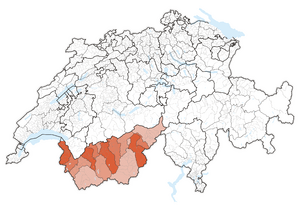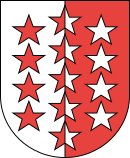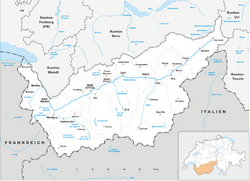Valais facts for kids
Quick facts for kids
|
||
|---|---|---|
|
||
 |
||
| Capital | Sion | |
| Subdivisions | 143 municipalities, 13 districts | |
| Area | ||
| • Total | 5,224 km2 (2,017 sq mi) | |
| Area rank | 3rd | |
| • Rank | 9th | |
| Highest point | 4,634 m (15,203 ft) - Monte Rosa | |
| Lowest point | 372 m (1,220 ft) - Lake Geneva | |
| Joined | 1815 | |
| Abbreviation | VS | |
| Languages | French, German | |
| Website | VS.ch | |
Valais is one of the 26 states, called cantons, in the southwest of Switzerland. It is a beautiful region known for its tall mountains and deep valleys.
The canton follows the Rhone River valley. This valley stretches from where the river starts to Lake Geneva. The Rhone River separates two big mountain ranges: the Pennine Alps and the Bernese Alps. Valais is one of the drier parts of Switzerland in its central valley. But it also has lots of snow and rain on its highest peaks. Valais is famous around the world for the amazing Matterhorn mountain.
Contents
Exploring Valais: Its Geography
The canton of Valais is located in southern Switzerland. To the south, it shares a border with Italy. To the southwest, it touches France. To the north, you'll find the Swiss cantons of Vaud and Bern. The cantons of Uri and Ticino are to its east.
The wide Rhone River valley is the most important feature of the area. Many smaller valleys branch off from this main valley. At the end of the Mattertal valley is Zermatt. This is a lovely tourist village. It offers amazing views of the Matterhorn, which is 4,478 meters (14,692 feet) tall. Valais has more than 50 mountains that are over 4,000 meters (13,123 feet) high! The tallest is Monte Rosa, reaching 4,638 meters (15,217 feet). There are also many large glaciers here.
The Rhone River flows through the main valley from east to west. It goes all the way to Martigny, Switzerland. Then, it turns sharply north towards Lake Geneva. After the small town of Saint-Maurice, the northern side of the river belongs to the canton of Vaud. The main valley sits between the Bernese Alps in the north and the Pennine Alps in the south. About half of the land in Valais is used for farming or other productive activities.
A Look at Valais's History
The ancient Romans called this area Vallis Poenina. This means "Upper Rhone Valley."
In the year 888, Valais became part of the kingdom of Jurane Burgundy.
In 999, King Rudolph III of Burgundy gave the area to the Bishop of Sion. He made the bishop the Count of Valais. The count-bishops had to protect their land from the dukes of Savoy.
In 1474, a battle took place near Sion, the capital. It was called the Battle of Planta. The Bishop of Sion and the people of Sieben Zenden defeated the Duke of Savoy. This battle was part of the Burgundy War. After this victory, the bishop took control of the land all the way to Lake Geneva.
Valais did not join the Protestant Reformation. This was a big religious change in Europe.
On March 12, 1529, Valais became a partner, or "associate member," of the Swiss Confederation.
In 1628, Valais became a republic. It was called the République des Sept Dizains. The bishop still had power. But then, Napoleon's troops invaded Valais. On March 16, 1798, they created the République du Valais. Soon after, on May 1, 1798, Valais became part of the Helvetic Republic. It became independent again in 1802 as the Rhodanic Republic.
In 1810, the Rhodanic Republic became part of France. It was then called the Simplon Department.
Valais became independent once more in 1813. On August 4, 1815, it decided to join the Swiss Confederation as a canton, or state.
In 1845, Valais joined a group called the Sonderbund. This was a league of Catholic cantons. However, Valais did not fight the federal troops when other members of the league started fighting in 1847.
Valais's Economy and Industries
Wine making and tourism are two of the most important industries in Valais. The Matterhorn mountain, near Zermatt, is a huge draw for tourists. Its nearby valley, Saas Fee, is also very popular. Other mountain areas in the west of the canton are well-liked too. These include French-speaking resorts near Verbier and the Evolene & Arolla region. Resorts on the north side of the main Rhone valley are also popular. They look out towards the Pennine Alps and are part of the Bernese Alps. One example is the family-friendly resort of Crans-Montana. The resorts in the Goms region are less known. Still, they attract visitors for summer hiking and winter skiing.
Besides tourism, farming is still very important. This includes raising cattle in the mountains. Dairy farming is common in the flatter areas. The wine industry in Valais is the biggest in all of Switzerland. There are also many fruit orchards. Saffron is also collected here.
The most industrial part of Valais is in the west, called Chablais. This area is very important for the economy. Many factories are located here. Important ones include branches of Novartis and Syngenta in Monthey. In the town of Collombey, there is an oil refinery.
Near Visp, there is a large factory that makes aluminum. Other metal products and chemicals are produced around Visp and Sierre.
Even with a busy tourist industry, good infrastructure, and many vineyards, Valais is still one of the less wealthy Swiss cantons. It is not as rich as the cantons known for banking and finance. A large part of the land and houses in Valais are now owned by people from other countries.
Getting Around: Transport in Valais
There is a small airport in Sion. However, the main ways to travel are by train and road. Both the rail and road networks are large and help with tourism. Many of the mountain passes are famous, like the Grimsel Pass. The Lötschberg Base Tunnel is one of the longest land tunnels in the world. It connects Frutigen in canton Bern with Visp in Valais. This tunnel helps spread car traffic and makes travel faster through the Bernese Alps. Cars can even be loaded onto trains as freight.
People and Languages: Demographics
Most people in Valais speak French. However, the eastern part of the canton, called Upper Valais, speaks Walliser German. About two-thirds of the people in Valais speak French.
The population is spread out across the canton. The largest towns are the capital Sion (also called Sitten), Sierre, and Brig. There isn't one very large city in the canton. Most of the people are Roman Catholic.
Main Towns and Villages
Related pages
- Sion, Switzerland - The capital city of the canton.
- French language
- German language
Aargau · Appenzell Innerrhoden · Appenzell Ausserrhoden · Basel-Stadt · Basel-Landschaft · Bern · Fribourg · Geneva · Glarus · Graubünden · Jura · Lucerne · Neuchâtel · Nidwalden · Obwalden · Schaffhausen · Schwyz · Solothurn · St. Gallen · Thurgau · Ticino · Uri · Valais · Vaud · Zug · Zürich
Images for kids
-
A view of Valais near the village of Grimentz in Val d'Anniviers
See also
 In Spanish: Cantón del Valais para niños
In Spanish: Cantón del Valais para niños









